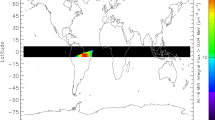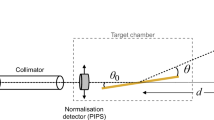Abstract
The experience gained with the current generation of X-ray telescopes like Chandra and XMM-Newton has shown that low energy “soft” protons can pose a severe threat to the possibility to exploit scientific data, reducing the available exposure times by up to 50% and introducing a poorly reproducible background component. These soft protons are present in orbits outside the radiation belts and enter the mirrors, being concentrated towards the focal plane instruments, losing energy along their path and finally depositing their remaining energy in the detectors. Their contribution to the residual background will be even higher for ATHENA with respect to previous missions, given the much higher collecting area of the mirrors, even if the instruments will likely suffer no significant radiation damage from this particles flux. As a consequence this soft proton flux shall be damped with the use of a magnetic diverter to avoid excess background loading on the WFI or X-IFU instruments. We present here a first complete evaluation of this background component for the two focal plane instruments of the ATHENA mission in absence of a magnetic diverter, and derive the requirements for such device to reduce the soft protons induced background below the level required to enable the mission science. We estimate the soft proton flux expected in L2 for the interplanetary component and for the component generated locally by acceleration processes in the magnetotail. We produce a proton response matrix for each of the two instruments of ATHENA focal plane, exploiting two independent Monte Carlo simulations to estimate the optics concentration efficiency, and Geant4 simulations to evaluate the energy loss inside the radiation filters and deposited in the detector. With this modular approach we derive the expected fluxes and spectra for the soft protons component of the background. Finally, we calculate the specifics of a magnetic diverter able to reduce such flux below the required level for both X-IFU and WFI.












Similar content being viewed by others
Notes
ATHENA Radiation Environment Models and X-Ray Background Effects Simulators
References
Agostinelli, S., Allison, J., Amako, K.: Geant4—a simulation toolkit. NIMA 506(3), 250–303 (2003)
Allison, J., Amako, K., Apostolakis, J.: Recent developments in Geant4. NIMA 835, 186–225 (2016)
Allison, J., Amako, K., Apostolakis, J.: Geant4 developments and applications. IEEE Trans. Nucl. Sci. 53(1), 270–278 (2006)
Barbera, M., Collura, A., Gatti, F.: Baseline design of the thermal blocking filters for the X-IFU detector on board ATHENA. Proc. SPIE 9144(91445U), 11 (2014)
Barbera, M., Argan, A., Bozzo, E., et al.: Thermal filters for the ATHENA X-IFU: Ongoing activities toward the conceptual design. JLTP 184, 706–711 (2016). https://doi.org/10.1007/s10909-016-1501-4. ISSN: 0022-2291
Bozzo, E., Barbera, M., Genolet, L., et al.: The filter wheel and filters development for the X-IFU instruments onboard Athena. In: Proceedings of SPIE, 9905, art. no. 990561. https://doi.org/10.1117/12.2232328 (2016)
Barbera, M., Branduardi-Raymont, G., Collura, A., et al.: The optical blocking filter for the ATHENA wide field imager: Ongoing activities towards the conceptual design. Proc. SPIE, 9601. https://doi.org/10.1117/12.2189326 (2015)
Christon, S.P., Gloeckler, G., Williams, et al.: Energetic atomic and molecular ions of ionospheric origin observed in distant magnetotail flow-reversal events. Geophys. Res. Lett. 21(25), 3023–3026 (1994). (ISSN 0094-8276)
Conti, G., Mattaini, E., Santambrogio, E.: X-ray characteristics of the Italian X-ray astronomy satellite (SAX) flight mirror units. Proc. SPIE 2279, 101–109 (1994). https://doi.org/10.1117/12.193179
Cusumano, G., Campana, S., Romano, P.: In-flight calibration of the swift XRT effective area, in gamma-ray bursts in the swift era. Nousek Am. Instit. Phys. Conf. Series 836, 664–667 (2006). https://doi.org/10.1063/1.2207972
De Luca, A., Molendi, S: The 2-8 keV cosmic X-ray background spectrum as observed with XMM-Newton. A&A 419, 837–848 (2004)
Dorman, B., Arnaud, K.A.: Redesign and Reimplementation of XSPEC. Payne Astron. Soc. Pacific Conf. Series 238, 415 (2001)
Eastman, T.E., Christon, S.P., Doke, T., et al.: Magnetospheric plasma regimes identified using Geotail measurements 1. Regime identification and distant tail variability. J. Geophys. Res. 103(A10), 23503–23520 (1998). https://doi.org/10.1029/98JA01915. (JGR Homepage)
Fioretti, V., Mineo, T., Bulgarelli, A.: Geant4 simulations of soft proton scattering in X-ray optics - A tentative validation using laboratory measurements. Experimental Astronomy. https://doi.org/10.1007/s10686-017-9559-9 (2017)
Fioretti, V., et al.: The Geant4 mass model of the ATHENA silicon pore optics and its effect on soft proton funneling. Proc. SPIE, in prep (2018)
Guzmán, A., Perinati, E., Diebold, S., Tenzer, C., Santangelo, A.: A revision of soft proton scattering at grazing incidence and its implementation in the GEANT4 toolkit. Exper. Astron. 44(3), 401–411 (2017). https://doi.org/10.1007/s10686-017-9537-2
Jacquey, C., Williams, D.J., McEntire, R.W., et al.: Tailward energetic ion streams observed at approximately 100 R(sub E) by GEOTAIL-EPIC associated with geomagnetic activity intensification. Geophys. Res. Lett. 21(25), 3015–3018 (1994). (ISSN 0094-8276)
Kaiser, M.L., Kucera, T.A., Davila, J.M., Cyr, O. C. S. t., Guhathakurta, M., Christian, E.: The STEREO mission: An introduction. Space Sci. Rev. 136 (1–4), 5–16 (2008)
Kuntz, K.D., Snowden, S.: The X-ray-emitting components toward l = 111: The local hot bubble and beyond. ApJ 674, 209–219 (2008)
Kuntz, K.D.: Presentation at IACHEC meeting (2014)
Leccardi, A., Molendi, S.: Radial temperature profiles for a large sample of galaxy clusters observed with XMM-Newton. A&A 486, 359–373 (2008)
Mineo, T., Lotti, S., Molendi, S., Ghizzardi, S.: An XMM-Newton proton response matrix. Experimental Astronomy, in press (2017)
Molendi, S.: Presentation at XMM Radiation Environement Workshop (2000)
Nartallo, R., et al.: Radiation environment induced degradation on Chandra and implications for XMM, ESA Report Esa/estec/tos-em/00-015/RN
Opitz, A., Sauvaud, J.-A., Klassen, A., Gomez-Herrero, R., Bucik, R., Kistler, L.M., Jacquey, C., Luhmann, J., Mason, G., Kajdic, P., Lavraud, B.: Solar wind control of the terrestrial magnetotail as seen by STEREO. J. Geophys. Res. Space Phys. 119, 63426355 (2014). https://doi.org/10.1002/2014JA019988
Remizovich, V.S., Ryazanov, M.I., Tilinin, I.S.: Energy and angular distributions of particles reflected in glancing incidence of a beam of ions on the surface of a material. Soviet J. Exper. Theor. Phys. 52, 225 (1980)
Rouquette, S., Jacquey, C., Le Contel, O., et al.: Fast tailward stream observed in the distant tail associated with substorm: A multi-instrument study. Geophys. Res. Lett. 27(21), 3571–3574 (2000)
Tiengo, A.: Constraining long-term and spatial variability of the pn low energy response with RXJ1856
Williams, D.J.: GEOTAIL energetic particle and ion composition instrument. J. Geomag. Geoelectr. 46, 39 (1994)
Willingale, R.: An electron diverter for the Swift telescope, XRA study note XRT-LUX-RE-011/1. University of Leicester (2000)
Acknowledgements
GEOTAIL/EPIC data have been provided by the Applied Physics Laboratory at John Hopkins University, Laurel, MD, USA. The GEOTAIL data analysis was partly performed with the AMDA science analysis system provided by the Centre de Données de la Physique des Plasmas (CDPP http://cdpp.eu/) supported by CNRS, CNES, Observatoire de Paris and Université Paul Sabatier, Toulouse.
Author information
Authors and Affiliations
Corresponding author
Additional information
This work is supported by the ESA “AREMBES” Contract No 4000116655/16/NL/BW.
Rights and permissions
About this article
Cite this article
Lotti, S., Mineo, T., Jacquey, C. et al. Soft proton flux on ATHENA focal plane and its impact on the magnetic diverter design. Exp Astron 45, 411–428 (2018). https://doi.org/10.1007/s10686-018-9599-9
Received:
Accepted:
Published:
Issue Date:
DOI: https://doi.org/10.1007/s10686-018-9599-9




